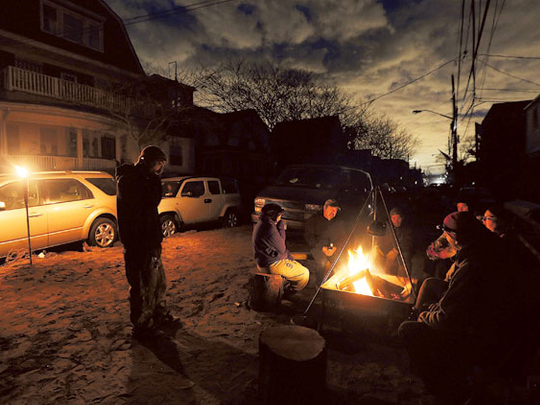
NEW YORK: Severe fuel shortages on Sunday threatened New York’s attempt to recover from superstorm Sandy as cold temperatures added to almost a week of misery exacerbated by flooded homes, limited public transportation and fraying tempers.
But on the bright side, power was restored to nearly all of Manhattan on Saturday after flooding plunged the lower half of New York’s most densely populated borough and famous skyline into darkness.
Manhattan will no longer resemble “some sort of ghost town or horror movie”, said Bob McGee, a spokesman for utility company Con Edison.
Crews were also working to restore supplies to schools, set to reopen on Monday, and to polling places for Tuesday’s presidential election.
However, 40 per cent of those who lost power, or somewhere under 900,000 people, continued to experience widespread outages that could last for as long as another week, New York Governor Andrew Cuomo told reporters.
For many, that meant no heating just as temperatures are dropping in the New York area, with a windy, rainy autumn storm forecast for Wednesday.
On Long Island, 550,000 people are without power, down from 1.2 million people initially, Cuomo said.
Overall, 2.5 million customers remain without power across seven states that were in Sandy’s path, the US Department of Energy said.
As New Jersey police raised the state’s death toll to 22, increasing the overall US total to at least 103, the biggest hurdle to recovery continued to be a severe lack of petrol.
Huge lines of cars and people on foot clutching canisters snaked back from petrol stations, and New Jersey governor Chris Christie announced rationing.
Starting Saturday, drivers with licence plates ending in an even number were only allowed to fill up on even-numbered dates, while those whose plates end in odd numbers plates had to wait for odd-number dates.
Meanwhile, New York officials announced the deployment of military fuel trucks offering 10 gallons (38 litres) of gasoline to drivers free of charge.
Cuomo said the critical situation should ease rapidly since delays in the arrival of fuel ships had been remedied.
“Eight million gallons of fuel have been delivered,” he said. “Twenty-eight million gallons will be delivered over the next two days, so you will see quickly an abatement of the pressure on the fuel system.”
“You don’t have to panic,” he added.
New figures from the federal Energy Information Administration said that 38 per cent of petrol stations around New York were still out of order, sharply down from 67 per cent on Friday.
Relief was slower than hoped for drivers who were told to stay away from makeshift fuel stations on the first day of the scheme to give priority to emergency vehicles. At one site in the Bronx, the promised fuel tanker had not arrived by late afternoon, according to an AFP correspondent.
The good news included the New York subway system being 80 per cent up and running. The transit authority ended the suspension of fares that had allowed New Yorkers to ride free during the calamity’s immediate aftermath.
New York City mayor Michael Bloomberg also announced that one million schoolchildren would be back in class on Monday, although there were 65 schools out of service due to damage or because they were being used as temporary shelters.
The military, meanwhile, said it had given emergency officials one million meals to distribute to the needy in New York and New Jersey, and would bring a further million next week.
But frustrations were increasingly boiling over in worst hit neighbourhoods.
On a visit to the far flung community of Rockaway Beach, which was severely flooded, mayor Bloomberg got an earful from angry residents.
“When are we going to get some help?” a woman yelled at him repeatedly before being ushered away by police.
Later, Bloomberg urged patience, telling reporters there were “many people who are worried, and frustrated, and cold. There is no power there and temperatures are dropping”.
Meanwhile, President Barack Obama, who is on the home stretch of his election campaign, spoke from Air Force One with Governor Chris Christie of New Jersey and Senators Chuck Schumer and Kirsten Gillibrand of New York to discuss the area’s recovery needs, the White House announced.
There was also commotion over the abrupt cancellation of Sunday’s annual New York marathon, due to be attended by 47,000 runners from all over the world.
Many of the runners who had spent heavily to come to New York said they understood the emergency, but were upset.
“I am gutted,” said Frenchman Jean-Michel Laurent. “This cost me 3,000 euros (Dh11,016). I don’t think I’ll be able to do it again.”
Wednesday’s bad weather was not expected to approach the severity of Sandy, but will still be miserable for people living in unheated and already damp houses.
The Red Cross said on Saturday it was accelerating efforts to set up enough warming shelters in time.
“Red Cross’ operational priorities right now are logistics, feeding and preparing for the pending storm,” Red Cross official Charley Shimanski told a news conference.
Throughout the region, “we’re working closely with emergency operations centres to stand up warming facilities, warming shelters, and stocking those with additional blankets, pillows and everything needed to make sure to take care of folks after the storm”, Shimanski said.












